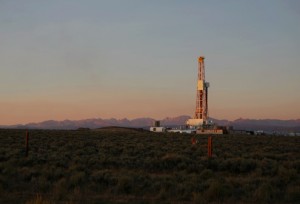Halliburton, the world’s second largest oilfield services company, is not in the habit of having to answer to the United States government. Thus, typically, it ignored a request from the Environmental Protection Agency, back in September, to share information about the chemicals the company routinely injects into this country’s underground water sources in order to retriever more natural gas out — a process called hydraulic fracturing.
But this is not George Bush’s EPA anymore (as it was overseen by VP Dick Cheney, former Halliburton CEO), and the other day Halliburton was served with a subpoena, an invitation that even Halliburton does not want to ignore. Of the nine companies the EPA asked for information on the subject, Halliburton was the only one that needed a legal order to comply. Congress has ordered the EPA to assess the threats to public health posed by the rapidly increasing use of hydraulic fracturing.
The process involves injecting water, sand, and an unknown number of unknown chemicals, under tremendous pressure, into a bed of shale deep underground that contains natural gas. The explosive impact fractures the shale, opens up new passageways and lets gas that is unavailable to ordinary drilling methods flow to the well. Because of this technique, estimates of America’s recoverable gas reserves have increased by over one-third in the past two years.
Hydraulic fracturing is now used in nine out of every ten of America’s gas wells. A 2004 study by George Bush’s EPA found that the process posed “no risk” to drinking water. Dick Cheney’s Congress immediately exempted fracking (as it’s called) from regulation under the Safe Drinking Water Act, an exemption that became known as “Halliburton Loophole.” The industry expects to be drilling more than 30,000 new wells a year soon.
The down side? Turns out that when you bomb underground chambers with chemicals and push gas around under pressure, its gets into other peoples’ water supply. Although the EPA saw “no risk,” there are now hundreds of cases of impaired or polluted groundwater associated with fracking in Alabama, Colorado, New Mexico, Virginia, West Virginia and Wyoming. The most common complaint involves methane, or natural gas, being where it shouldn’t (and blowing up things it shouldn’t, like houses).
There’s also the matter of those chemicals used in fracking. The companies try very hard not to reveal what they are — trade secrets, you know. But of the 300 whose use is suspected by government and other researchers — including barium, strontium, benzene, toluene, ethanol, and nonylphenols, diesel fuel, acetone, boric acid, ethelyene glycol, isopropanol, hydrochloric acid and/or formic acid — 65 are hazardous. Industry spokespeople reassure us by saying, according to a ProPublica report, that releasing specific details would only frighten and confuse the public. Indeed. Nothing is more frightening than when industry says that.
The EPA says it is going to be hard pressed to complete its report to Congress by the due date, early 2012. The agency should relax. The Congress has just been returned to the control of the authors of the Halliburton Loophole, they’re not going to just sit there and let the EPA close it. The chances that Halliburton can go back to ignoring the United States government real soon are very good.
